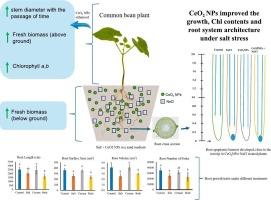纳米氧化铈颗粒和盐度对蚕豆(Phaseolus vulgaris)生长、生理以及根系结构和解剖特征的影响。
IF 4.7
3区 环境科学与生态学
Q2 ENVIRONMENTAL SCIENCES
引用次数: 0
摘要
由于广泛应用于各行各业,工程纳米粒子(ENPs)已成为全球性污染物,尤其引起人们对农业环境的关注。本研究探讨了在土壤普遍盐碱化的背景下,ENPs(特别是氧化铈纳米粒子(CeO₂NPs))与氯化钠(NaCl)在农作物中的相互作用。在温室条件下,采用完全随机的实验设计,将'Pinto'普通豆苗栽培在装满沙子的花盆中,为期一个月。共进行了四种处理:(1) 不含 NaCl 和 CeO₂NPs 的对照组;(2) 不含 CeO₂NPs 的 50 mM NaCl;(3) 不含 NaCl 的 200 mg kg-1 CeO₂NPs;(4) 50 mM NaCl 和 200 mg kg-1 CeO₂NPs 的组合。每周进行一次测量,并随机抽取 20 株植物,包括每个处理中的 5 株。实验结束后,将最后一批植株解剖成地上和地下器官,以确定 Ce 和 Na 的浓度,并对根部进行扫描,以分析根系的结构特征。结果显示,在根系结构(包括长度、表面积和体积)、解剖特征、生物量(新鲜和干燥)和藤蔓长度等生长方面存在显著差异。同样,在荧光、Ce 和 Na 浓度、电解质渗漏(CeO2NPs + NaCl 处理的渗漏量是对照的 3.3 倍)和叶绿素含量(CeO2NPs 处理的叶绿素 a 是 NaCl 处理的 3.3 倍)方面也观察到显著差异。此外,还观察到 NaCl 与 CeO₂NPs 在根凋亡屏障形成、藤蔓长度、Ce 吸收以及叶绿素含量和荧光方面的显著相互作用。本文章由计算机程序翻译,如有差异,请以英文原文为准。

Influences of cerium oxide nanoparticles and salinity on common bean (Phaseolus vulgaris) growth, physiology, and root system architectural and anatomical traits
Engineered nanoparticles (ENPs) have emerged as global pollutants due to their extensive use across various industries, raising particular concerns in agricultural settings. This study addresses the understudied interactions between ENPs, specifically cerium oxide nanoparticles (CeO₂NPs), and sodium chloride (NaCl) in agricultural crops, within the context of widespread soil salinization. ‘Pinto’ common bean seedlings were cultivated in sand-filled pots under greenhouse conditions, following a completely randomized experimental design for one month. Four treatments were administered: (1) control with no NaCl and no CeO₂NPs, (2) 50 mM NaCl without CeO₂NPs, (3) 200 mg kg−1 CeO₂NPs without NaCl, and (4) a combination of 50 mM NaCl and 200 mg kg−1 CeO₂NPs. Weekly measurements were conducted, and a random cohort of 20 plants, including 5 from each treatment, was destructively sampled. At the experiment's conclusion, the final cohort was dissected into above- and below-ground organs to determine the concentrations of Ce and Na, and root scans were performed to analyze root system architectural traits. The results revealed significant differences in growth including root system architecture (including length, surface area, and volume), anatomical traits, biomass (fresh and dry), and vine length. Similarly, significant differences were observed in fluorescence; Ce and Na concentrations; electrolyte leakage, with the CeO2NPs + NaCl treatment having 3.3-fold more leakage than the control; and chlorophyll contents, with the CeO2NPs treatment having 3.3-fold more chlorophyll a than the NaCl treatment. Additionally, notable interactions between NaCl and CeO₂NPs were observed in root apoplastic barrier formation, vine length, Ce uptake, and chlorophyll content and fluorescence.
求助全文
通过发布文献求助,成功后即可免费获取论文全文。
去求助
来源期刊

NanoImpact
Social Sciences-Safety Research
CiteScore
11.00
自引率
6.10%
发文量
69
审稿时长
23 days
期刊介绍:
NanoImpact is a multidisciplinary journal that focuses on nanosafety research and areas related to the impacts of manufactured nanomaterials on human and environmental systems and the behavior of nanomaterials in these systems.
 求助内容:
求助内容: 应助结果提醒方式:
应助结果提醒方式:


